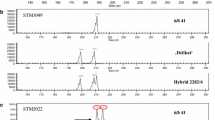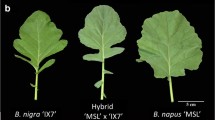Summary
With the idea to develop a selection system for asymmetric somatic hybrids between oilseed rape (Brassica napus) and black mustard (B. nigra), the marker gene hygromycin resistance was introduced in this last species by protoplast transformation with the disarmed Agrobacterium tumefaciens strain C58 pGV 3850 HPT. The B. nigra lines used for transformation had been previously selected for resistance to two important rape pathogens (Phoma lingam, Plasmodiophora brassicae). Asymmetric somatic hybrids were obtained through fusion of X-ray irradiated (mitotically inactivated) B. nigra protoplasts from transformed lines as donor with intact protoplasts of B. napus, using the hygromycin resistance as selection marker for fusion products. The somatic hybrids hitherto obtained expressed both hygromycin phosphotransferase and nopaline synthase genes. Previous experience with other plant species had demonstrated that besides the T-DNA, other genes of the donor genome can be co-transferred. In this way, the produced hybrids constitute a valuable material for studying the possibility to transfer agronomically relevant characters — in our case, diseases resistances — through asymmetric protoplast fusion.
Similar content being viewed by others
References
Chuong PV, Pauls KP, Beversdorf WD (1987) Plant regeneration from Brassica nigra (L.) Koch stem protoplasts. In Vitro Cell Developm Biol 23:449–452
Diederichsen E, Sacristán MD, Schieder O (1989) Combination of clubroot resistances in artificial rape seed forms (Brassica napus). Abstr. Vortr Pflanzenzuecht 15:17–11
Gamborg OL, Miller RA, Ojima K (1968) Nutrient requirements of suspension cultures of soybean root cells. Exp Cell Res 50:151–158
Glimelius K (1984) High growth rate and regeneration capacity of hypocotyl protoplasts in some Brassicaceae. Physiol Plant 61:38–44
Hepburn AG, Clarke LE, Pearson L, White J (1983) The role of cytosine methylation in the control of nopaline synthase gene expression in a plant tumor. J Mol Appl Genet 2:315–329
Imamura J, Saul MW, Potrykus I (1987) X-ray irradiation promoted asymmetric somatic hybridisation and molecular analysis of the products. Theor Appl Genet 74:445–450
Kirti PB (1988) Somatic embryogenesis in hypocotyl protoplast culture of rapeseed (Brassica napus L.). Plant Breed 100:222–224
Köhler F, Afsar K, Golz C, Eapen S, Schieder O (1988) Transformation studies in tobacco, moth bean and Brassica species. In: Puite KJ, Dons JJM, Huizing HJ, Kool AJ, Koornneef M, Krens FA (eds) Progress in plant protoplast research. Kluwer, Dordrecht, pp 359–362
Li L, Kohlenbach HW (1982) Somatic embryogenesis in quite a direct way in cultures of mesophyll protoplasts of Brassica napus L. Plant Cell Rep 1:209–211
Menczel L, Morgan A, Brown S, Maliga P (1987) Fusion-mediated combination of Ogura-type cytoplasmic male sterility with Brassica napus plastids using X-irradiated CMS protoplasts. Plant Cell Rep 6:98–101
Müller-Gensert E, Schieder O (1987) Interspecific T-DNA transfer through plant protoplast fusion. Mol Gen Genet 208:235–241
Murashige T, Skoog F (1962) Revised media for rapid growth and bioassays with tobacco tissue culture. Physiol Plant 15:473–497
Otten L, Schilperoort RA (1978) A rapid microscale method for the detection of lysopine and nopaline dehydrogenase activities. Biochem Biophys Acta 527:497–500
Peerbolte R, Leenhouts K, Hooykaas-van Slogteren GMS, Wullems GJ, Schilperoort RA (1986) Clones from a shooty tobacco crown gall tumor. II: irregular T-DNA structures and organization, T-DNA methylation and conditional expression of opine genes. Plant Mol Biol 7:285–299
Sacristán MD (1981) Regeneration of plants from long-term callus cultures of haploid Brassica napus. Z Pflanzenzücht 86:248–253
Sacristán MD, Gerdemann M (1986) Different behavior of Brassica juncea and B. carinata as sources of Phoma lingam resistance in experiments of interspecific transfer to B. napus. Plant Breed 97:304–314
Sacristán MD, Gerdemann-Knörck M, Schieder O (1988) Transformation of Brassica nigra through protoplast cocultivation with Agrobacterium tumefaciens. In: Puite KJ, Dons JJM, Huizing HJ, Kool AJ, Koornneef M, Krens FA (eds) Progress in plant protoplast research. Kluwer, Dordrecht, pp 351–352
Schieder O (1984) Isolation and culture of protoplasts: Datura. In: Vasil I (ed) Cell culture and somatic cell genetics of plants, vol 1. Academic Press, Orlando, pp 350–355
Shields CR, Orton Tj, Stuber CW (1983) An outline of general resource needs and procedures for the electrophoretic separation of active enzymes from plant tissue. In: Tanksley SD, Orton TJ (eds) Isozymes in plant genetics and breeding, part A. Elsevier, Amsterdam, pp 443–468
Sidorov VA, Zubko MK, Kuchko YY, Komarnitsky IK, Gleba YY (1987) Somatic hybridization in potato: use of gammairradiated protoplasts of Solanum pinnatisectum in genetic reconstruction. Theor Appl Genet 74:364–368
Sjödin C, Glimelius K (1988) Selection for resistance to Phoma lingam using pycnospore infections of plants in vivo and sirodesmin PL as selective agent in vitro. In: Puite KJ, Dons JJM, Huizing HJ, Kool AJ, Koornneef M, Krens FA (eds) Progress in plant protoplast research. Kluwer, Dordrecht, pp 289–292
Van den Elzen PJM, Townsend J, Lee KY, Bedbrook JR (1985) A chimaeric hygromycin resistance gene as a selectable marker in plant cells. Plant Mol Biol 5:299–302
Author information
Authors and Affiliations
Additional information
Communicated by G. Wenzel
Rights and permissions
About this article
Cite this article
Sacristán, M.D., Gerdemann-Knörck, M. & Schieder, O. Incorporation of hygromycin resistance in Brassica nigra and its transfer to B. napus through asymmetric protoplast fusion. Theoret. Appl. Genetics 78, 194–200 (1989). https://doi.org/10.1007/BF00288799
Received:
Accepted:
Issue Date:
DOI: https://doi.org/10.1007/BF00288799




